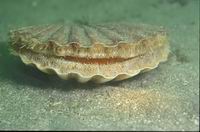Diver Harvested Scallops
| The information on this page is brought to you by Seafish and FSA(Scotland). Divers harvesting and supplying scallops have certain responsibilities under EU and UK Law. This web page aims to provide information and guidance to help you provide a seafood product which is safe to eat and meet your legal obligations’

Contents
1. Legislation and Diver Harvested Scallops 2. Outline of Key Diver Responsibilities 3. Algal Toxin Testing Criteria 4. Critical Documentation for scallop suppliers 5. Criteria for the classification of shellfish harvesting areas 6. End Product Testing criteria. ______________________________________________________________
Regulation
854/2004 _______________________________________________________________
_______________________________________________________________
Criteria
for the classification of shellfish
harvesting areas.
All inshore areas used for harvesting King Scallops must be classified by the regulator prior to harvesting. This
classification of shellfish beds is
based on the numbers of certain bacteria
(E.coli) found in bivalve molluscs
recorded over a period of time.
• Class A: less than 230 Colony Forming
Units (CFU). Harvested for direct
human consumption.
• Class B: 230 – 4,600 CFU. Must be
purified (cleansed of bacteria through
an approved depuration unit), relayed
in an approved Class A relaying area,
or heat treated by approved method
before selling for human consumption.
• Class C: 4,600 – 46,000 CFU. Must
be relayed (for a minimum of two months)
to meet Class A or B, or be heat treated.
• Prohibited area: 46,000 + CFU. No
harvesting for human consumption
_______________________________________________________________
Scallop Poster (not currently available) While stocks last, a free A3 scallop poster can be obtained by sending a (large) Stamped Addressed envelope to Scallop Poster Seafish Training Humber Seafood Institute Europarc Grimsby DN37 9TZ
The poster will be folded. If you would like your poster delivered rolled up in a tube then please send a contribution to the cost of posting (£??) to Seafish. |
||||

